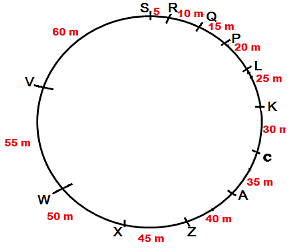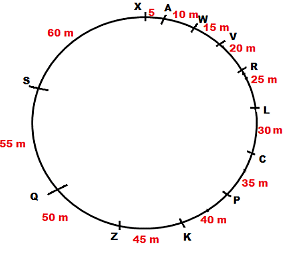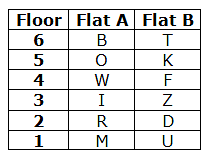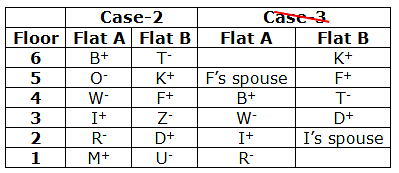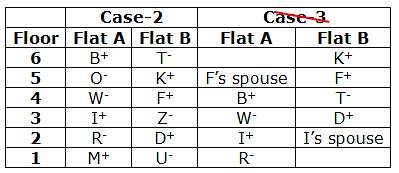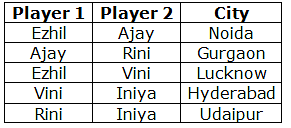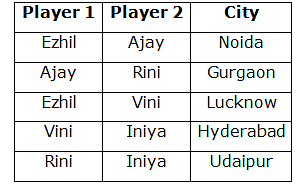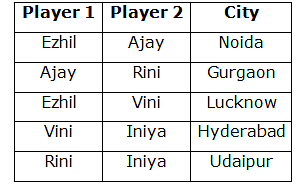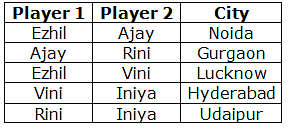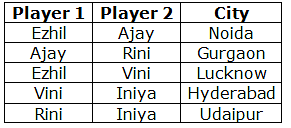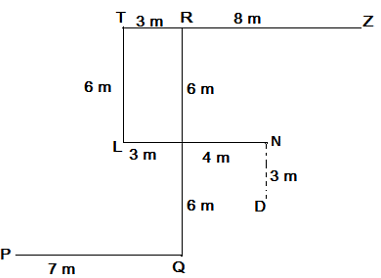SBI PO Mains Mock Test - 3 (New Pattern) - Bank Exams MCQ
30 Questions MCQ Test Mock Tests for Banking Exams 2024 - SBI PO Mains Mock Test - 3 (New Pattern)
Directions: Study the information carefully and answer the question.
Certain persons are sitting around a circular table which has a circumference of 390 m and all of them are facing towards the centre. They are sitting at certain distances from each other, which are consecutive multiples of 5 in clockwise direction. K is not an immediate neighbour of R. Distance between S and Z is more than 100 m, but less than 110 m. L is sitting second to the left of V, who is sitting 30 m away to the left of X. Distance between R and P is 90 m. K is sitting 2nd to the right of Q. Distance between A and W is the LCM of 5 and 2. Distance between C and K is 75 m. Number of persons sitting between S and Z is one less than the number of persons sitting between A and R. Distance between Q and K is 95 m. Z is the neighbour of both Q and K.
If all the persons are arranged to sit in alphabetical order starting from P's position in anticlockwise direction, then position of how many person(s) remain(s) unchanged?
Directions: Study the information carefully and answer the question.
Certain persons are sitting around a circular table which has a circumference of 390 m and all of them are facing towards the centre. They are sitting at certain distances from each other, which are consecutive multiples of 5 in clockwise direction. K is not an immediate neighbour of R. Distance between S and Z is more than 100 m, but less than 110 m. L is sitting second to the left of V, who is sitting 30 m away to the left of X. Distance between R and P is 90 m. K is sitting 2nd to the right of Q. Distance between A and W is the LCM of 5 and 2. Distance between C and K is 75 m. Number of persons sitting between S and Z is one less than the number of persons sitting between A and R. Distance between Q and K is 95 m. Z is the neighbour of both Q and K.
How many persons are sitting between R and Q, when counted from R in anticlockwise direction?
| 1 Crore+ students have signed up on EduRev. Have you? Download the App |
Directions: Study the information carefully and answer the question.
Certain persons are sitting around a circular table which has a circumference of 390 m and all of them are facing towards the centre. They are sitting at certain distances from each other, which are consecutive multiples of 5 in clockwise direction. K is not an immediate neighbour of R. Distance between S and Z is more than 100 m, but less than 110 m. L is sitting second to the left of V, who is sitting 30 m away to the left of X. Distance between R and P is 90 m. K is sitting 2nd to the right of Q. Distance between A and W is the LCM of 5 and 2. Distance between C and K is 75 m. Number of persons sitting between S and Z is one less than the number of persons sitting between A and R. Distance between Q and K is 95 m. Z is the neighbour of both Q and K.
If positions of Z and C are interchanged, then how far will Z be from W when counted from the left of W?
Directions: Study the information carefully and answer the question.
Certain persons are sitting around a circular table which has a circumference of 390 m and all of them are facing towards the centre. They are sitting at certain distances from each other, which are consecutive multiples of 5 in clockwise direction. K is not an immediate neighbour of R. Distance between S and Z is more than 100 m, but less than 110 m. L is sitting second to the left of V, who is sitting 30 m away to the left of X. Distance between R and P is 90 m. K is sitting 2nd to the right of Q. Distance between A and W is the LCM of 5 and 2. Distance between C and K is 75 m. Number of persons sitting between S and Z is one less than the number of persons sitting between A and R. Distance between Q and K is 95 m. Z is the neighbour of both Q and K.
What is the distance between X and P, when counted from the right of X?
Directions: Study the information carefully and answer the question.
Certain persons are sitting around a circular table which has a circumference of 390 m and all of them are facing towards the centre. They are sitting at certain distances from each other, which are consecutive multiples of 5 in clockwise direction. K is not an immediate neighbour of R. Distance between S and Z is more than 100 m, but less than 110 m. L is sitting second to the left of V, who is sitting 30 m away to the left of X. Distance between R and P is 90 m. K is sitting 2nd to the right of Q. Distance between A and W is the LCM of 5 and 2. Distance between C and K is 75 m. Number of persons sitting between S and Z is one less than the number of persons sitting between A and R. Distance between Q and K is 95 m. Z is the neighbour of both Q and K.
Four of the following five pairs belong to a group. Find the one which does not belong to that group.
Study the following information carefully and answer the below questions
Six couples are living in a six-storey building such that the bottommost floor is numbered as one and the floor immediately above it is numbered as 2 and so on.
Note I: Each floor has 2 flats viz., flat A and flat B. Flat A is to the west of Flat B.
Note II: Flat A of floor 2 is immediately above flat A of floor 1 and immediately below flat A of Floor 3 and so on.
Note III: The person whose name starts with the first half of the English alphabetical series is a male member. The couples are living on the same floor of the building.
K lives three floors above the one who is the spouse of D. Both K’s spouse and D’s spouse live in the same flat. F’s spouse lives immediate southwest of K. The number of floors above F is one more than the number of floors below R. W lives two floors above R and both live in the same flat. B’s spouse lives northeast of W. The number of floors between B and R is one more than the number of floors between T and I. I’s spouse lives southeast of K’s spouse. Not more than two floors are between I’s spouse and B’s spouse. The number of floors above U is one more than the number of floors below O. M lives southwest of Z. U doesn’t live above Z.
Who among the following person is the spouse of F?
Study the following information carefully and answer the below questions
Six couples are living in a six-storey building such that the bottommost floor is numbered as one and the floor immediately above it is numbered as 2 and so on.
Note I: Each floor has 2 flats viz., flat A and flat B. Flat A is to the west of Flat B.
Note II: Flat A of floor 2 is immediately above flat A of floor 1 and immediately below flat A of Floor 3 and so on.
Note III: The person whose name starts with the first half of the English alphabetical series is a male member. The couples are living on the same floor of the building.
K lives three floors above the one who is the spouse of D. Both K’s spouse and D’s spouse live in the same flat. F’s spouse lives immediate southwest of K. The number of floors above F is one more than the number of floors below R. W lives two floors above R and both live in the same flat. B’s spouse lives northeast of W. The number of floors between B and R is one more than the number of floors between T and I. I’s spouse lives southeast of K’s spouse. Not more than two floors are between I’s spouse and B’s spouse. The number of floors above U is one more than the number of floors below O. M lives southwest of Z. U doesn’t live above Z.
Who among the following person lives in flat B?
Study the following information carefully and answer the below questions
Six couples are living in a six-storey building such that the bottommost floor is numbered as one and the floor immediately above it is numbered as 2 and so on.
Note I: Each floor has 2 flats viz., flat A and flat B. Flat A is to the west of Flat B.
Note II: Flat A of floor 2 is immediately above flat A of floor 1 and immediately below flat A of Floor 3 and so on.
Note III: The person whose name starts with the first half of the English alphabetical series is a male member. The couples are living on the same floor of the building.
K lives three floors above the one who is the spouse of D. Both K’s spouse and D’s spouse live in the same flat. F’s spouse lives immediate southwest of K. The number of floors above F is one more than the number of floors below R. W lives two floors above R and both live in the same flat. B’s spouse lives northeast of W. The number of floors between B and R is one more than the number of floors between T and I. I’s spouse lives southeast of K’s spouse. Not more than two floors are between I’s spouse and B’s spouse. The number of floors above U is one more than the number of floors below O. M lives southwest of Z. U doesn’t live above Z.
What is the direction of U’s spouse with respect to O’s spouse?
Study the following information carefully and answer the below questions
Six couples are living in a six-storey building such that the bottommost floor is numbered as one and the floor immediately above it is numbered as 2 and so on.
Note I: Each floor has 2 flats viz., flat A and flat B. Flat A is to the west of Flat B.
Note II: Flat A of floor 2 is immediately above flat A of floor 1 and immediately below flat A of Floor 3 and so on.
Note III: The person whose name starts with the first half of the English alphabetical series is a male member. The couples are living on the same floor of the building.
K lives three floors above the one who is the spouse of D. Both K’s spouse and D’s spouse live in the same flat. F’s spouse lives immediate southwest of K. The number of floors above F is one more than the number of floors below R. W lives two floors above R and both live in the same flat. B’s spouse lives northeast of W. The number of floors between B and R is one more than the number of floors between T and I. I’s spouse lives southeast of K’s spouse. Not more than two floors are between I’s spouse and B’s spouse. The number of floors above U is one more than the number of floors below O. M lives southwest of Z. U doesn’t live above Z.
O’s spouse lives on which of the following floor and flat?
Directions: In the following question, two statements numbered I and II are given. There may be cause and effect relationship between the two statements. These two statements may be the effect of the same cause or independent causes. These statements may be independent causes without having any relationship. Read both the statements in the question and mark your answer as:
(1) if statement I is the cause and statement II is its effect;
(2) if statement II is the cause and statement I is its effect;
(3) if both statements I and II are independent causes;
(4) if both statements I and II are effects of independent causes; and
(5) if both statements I and II are effects of some common cause.
I. The government has increased the minimum procurement price of sugarcane to be offered to farmers.
II. The farmers have decided not to sell their sugarcane to the private sugar plant.
Directions: In the following question, two statements numbered I and II are given. There may be cause and effect relationship between the two statements. These two statements may be the effect of the same cause or independent causes. These statements may be independent causes without having any relationship. Read both the statements in the question and mark your answer as:
(1) if statement I is the cause and statement II is its effect;
(2) if statement II is the cause and statement I is its effect;
(3) if both statements I and II are independent causes;
(4) if both statements I and II are effects of independent causes; and
(5) if both statements I and II are effects of some common cause.
I. The performance of Indian athletics team has been excellent in the recent Olympic Games.
II. The performance of Indian athletics team was pathetic in the last two Olympic Games.
Directions: In the following question, two statements numbered I and II are given. There may be cause and effect relationship between the two statements. These two statements may be the effect of the same cause or independent causes. These statements may be independent causes without having any relationship. Read both the statements in the question and mark your answer as:
(1) if statement I is the cause and statement II is its effect;
(2) if statement II is the cause and statement I is its effect;
(3) if both statements I and II are independent causes;
(4) if both statements I and II are effects of independent causes; and
(5) if both statements I and II are effects of some common cause.
I. The state government has recently asked the state education board to release pending DA instalment of government teachers as it has been pending for 6 months.
II. The govt teachers had launched a severe protest against the DEO earlier this month for release of DA.
Directions: In the following question, two statements numbered I and II are given. There may be cause and effect relationship between the two statements. These two statements may be the effect of the same cause or independent causes. These statements may be independent causes without having any relationship. Read both the statements in the question and mark your answer as:
(1) if statement I is the cause and statement II is its effect;
(2) if statement II is the cause and statement I is its effect;
(3) if both statements I and II are independent causes;
(4) if both statements I and II are effects of independent causes; and
(5) if both statements I and II are effects of some common cause.
I. The underpaid employees of all the district municipal corporations of the state have given an indefinite protest call starting from next week.
II. The government has taken severe action against those municipal corporation employees who are involved in corruption.
Study the following information carefully and answer the questions given below
Five persons from the table tennis academy-Ezhil, Iniya, Ajay, Rini, and Vini participated in a doubles table tennis competition. A pair among the five participated in a match on each day in different cities viz., Lucknow, Noida, Udaipur, Hyderabad and Gurgaon. In some of the cities, they are not able to win the match but after the tournament gets over, each person returns with the winning trophy. Each person wins the trophy in only two different cities.
Vini did not win the trophy in Udaipur and Noida. Ajay is part of two pairs but he did not win the trophy with Vini and Iniya. Rini did not win the trophy in Hyderabad. Iniya is part of the pair which wins the trophy in Udaipur. Ezhil and Vini have together won the trophy. Neither Iniya nor Rini wins the trophy in Lucknow and Noida. Vini and Rini together have not won the trophy.
Which of the following pair of persons win the trophy in Hyderabad?
Study the following information carefully and answer the questions given below
Five persons from the table tennis academy-Ezhil, Iniya, Ajay, Rini, and Vini participated in a doubles table tennis competition. A pair among the five participated in a match on each day in different cities viz., Lucknow, Noida, Udaipur, Hyderabad and Gurgaon. In some of the cities, they are not able to win the match but after the tournament gets over, each person returns with the winning trophy. Each person wins the trophy in only two different cities.
Vini did not win the trophy in Udaipur and Noida. Ajay is part of two pairs but he did not win the trophy with Vini and Iniya. Rini did not win the trophy in Hyderabad. Iniya is part of the pair which wins the trophy in Udaipur. Ezhil and Vini have together won the trophy. Neither Iniya nor Rini wins the trophy in Lucknow and Noida. Vini and Rini together have not won the trophy.
Which of the following pair is not successfully winning any trophy?
I. Rini-Ezhil
II. Ezhil-Iniya
III. Ajay-Vini
Study the following information carefully and answer the questions given below
Five persons from the table tennis academy-Ezhil, Iniya, Ajay, Rini, and Vini participated in a doubles table tennis competition. A pair among the five participated in a match on each day in different cities viz., Lucknow, Noida, Udaipur, Hyderabad and Gurgaon. In some of the cities, they are not able to win the match but after the tournament gets over, each person returns with the winning trophy. Each person wins the trophy in only two different cities.
Vini did not win the trophy in Udaipur and Noida. Ajay is part of two pairs but he did not win the trophy with Vini and Iniya. Rini did not win the trophy in Hyderabad. Iniya is part of the pair which wins the trophy in Udaipur. Ezhil and Vini have together won the trophy. Neither Iniya nor Rini wins the trophy in Lucknow and Noida. Vini and Rini together have not won the trophy.
Which of the following statement is true with respect to the final arrangement?
Study the following information carefully and answer the questions given below
Five persons from the table tennis academy-Ezhil, Iniya, Ajay, Rini, and Vini participated in a doubles table tennis competition. A pair among the five participated in a match on each day in different cities viz., Lucknow, Noida, Udaipur, Hyderabad and Gurgaon. In some of the cities, they are not able to win the match but after the tournament gets over, each person returns with the winning trophy. Each person wins the trophy in only two different cities.
Vini did not win the trophy in Udaipur and Noida. Ajay is part of two pairs but he did not win the trophy with Vini and Iniya. Rini did not win the trophy in Hyderabad. Iniya is part of the pair which wins the trophy in Udaipur. Ezhil and Vini have together won the trophy. Neither Iniya nor Rini wins the trophy in Lucknow and Noida. Vini and Rini together have not won the trophy.
In which of the following city Iniya and Vini successfully win the trophy?
Directions: Study the following information and answer the question.
There is a 4*5 matrix which gives indications that in turn help in picking different types of toys in a game. The rows of the matrix are denoted by %, ^, & and # from top to bottom and the columns are denoted by the letters P, Q, R, S and T from left to right.
% row contains numbers which are consecutive prime numbers till 47, starting from 31 (from right to left).
^ row contains numbers which are consecutive prime numbers till 71, starting from 53 (from right to left).
& row contains numbers which are consecutive square numbers till 121, starting from 49 (from right to left).
# row contains numbers which are consecutive cube numbers till 216, starting from 8 (from right to left).
The matrix allows children to pick toys of their wish which is a single string of numbers 'X'.
There are 4 toys - Car, Doll, Ball and Teddy. Based on the outcome of the string mentioned above, one of the toys is picked.
Condition for different toys:
1. If the outcome is below 50, then Car will be picked.
2. If the outcome range is 50-75, then Doll will be picked.
3. If the outcome range is 75-100, then Ball will be picked.
4. If the outcome is greater than 100, then Teddy will be picked.
For outcome of the string:
1. If there are two 3-digit numbers, then the outcome is obtained by finding the difference between the sum of three-digit numbers and the sum of two-digit numbers in the string.
2. If the string has only one 3-digit number, then the outcome is obtained by finding the difference between the sum of first two numbers and the sum of next two numbers in the string.
3. If the whole string is made of square and cube numbers, then the outcome is obtained by finding the difference between the sum of cube numbers and the sum of square numbers.
4. If the string has no 3-digit numbers, then the outcome is obtained by deleting the digits in the ones place and multiplying the digits in the tens place.
5. If no above logic is followed, then simple outcome is addition of digits of all the numbers.
If X = #T &R #S &T, then which toy will be picked?
Directions: Study the following information and answer the question.
There is a 4*5 matrix which gives indications that in turn help in picking different types of toys in a game. The rows of the matrix are denoted by %, ^, & and # from top to bottom and the columns are denoted by the letters P, Q, R, S and T from left to right.
% row contains numbers which are consecutive prime numbers till 47, starting from 31 (from right to left).
^ row contains numbers which are consecutive prime numbers till 71, starting from 53 (from right to left).
& row contains numbers which are consecutive square numbers till 121, starting from 49 (from right to left).
# row contains numbers which are consecutive cube numbers till 216, starting from 8 (from right to left).
The matrix allows children to pick toys of their wish which is a single string of numbers 'X'.
There are 4 toys - Car, Doll, Ball and Teddy. Based on the outcome of the string mentioned above, one of the toys is picked.
Condition for different toys:
1. If the outcome is below 50, then Car will be picked.
2. If the outcome range is 50-75, then Doll will be picked.
3. If the outcome range is 75-100, then Ball will be picked.
4. If the outcome is greater than 100, then Teddy will be picked.
For outcome of the string:
1. If there are two 3-digit numbers, then the outcome is obtained by finding the difference between the sum of three-digit numbers and the sum of two-digit numbers in the string.
2. If the string has only one 3-digit number, then the outcome is obtained by finding the difference between the sum of first two numbers and the sum of next two numbers in the string.
3. If the whole string is made of square and cube numbers, then the outcome is obtained by finding the difference between the sum of cube numbers and the sum of square numbers.
4. If the string has no 3-digit numbers, then the outcome is obtained by deleting the digits in the ones place and multiplying the digits in the tens place.
5. If no above logic is followed, then simple outcome is addition of digits of all the numbers.
If X = %Q #S ^R %T, then which toy will be picked?
Directions: Study the following information and answer the question.
There is a 4*5 matrix which gives indications that in turn help in picking different types of toys in a game. The rows of the matrix are denoted by %, ^, & and # from top to bottom and the columns are denoted by the letters P, Q, R, S and T from left to right.
% row contains numbers which are consecutive prime numbers till 47, starting from 31 (from right to left).
^ row contains numbers which are consecutive prime numbers till 71, starting from 53 (from right to left).
& row contains numbers which are consecutive square numbers till 121, starting from 49 (from right to left).
# row contains numbers which are consecutive cube numbers till 216, starting from 8 (from right to left).
The matrix allows children to pick toys of their wish which is a single string of numbers 'X'.
There are 4 toys - Car, Doll, Ball and Teddy. Based on the outcome of the string mentioned above, one of the toys is picked.
Condition for different toys:
1. If the outcome is below 50, then Car will be picked.
2. If the outcome range is 50-75, then Doll will be picked.
3. If the outcome range is 75-100, then Ball will be picked.
4. If the outcome is greater than 100, then Teddy will be picked.
For outcome of the string:
1. If there are two 3-digit numbers, then the outcome is obtained by finding the difference between the sum of three-digit numbers and the sum of two-digit numbers in the string.
2. If the string has only one 3-digit number, then the outcome is obtained by finding the difference between the sum of first two numbers and the sum of next two numbers in the string.
3. If the whole string is made of square and cube numbers, then the outcome is obtained by finding the difference between the sum of cube numbers and the sum of square numbers.
4. If the string has no 3-digit numbers, then the outcome is obtained by deleting the digits in the ones place and multiplying the digits in the tens place.
5. If no above logic is followed, then simple outcome is addition of digits of all the numbers.
If X = ^R &T #Q #R, then which toy will be picked?
Directions: Study the following information and answer the question.
There is a 4*5 matrix which gives indications that in turn help in picking different types of toys in a game. The rows of the matrix are denoted by %, ^, & and # from top to bottom and the columns are denoted by the letters P, Q, R, S and T from left to right.
% row contains numbers which are consecutive prime numbers till 47, starting from 31 (from right to left).
^ row contains numbers which are consecutive prime numbers till 71, starting from 53 (from right to left).
& row contains numbers which are consecutive square numbers till 121, starting from 49 (from right to left).
# row contains numbers which are consecutive cube numbers till 216, starting from 8 (from right to left).
The matrix allows children to pick toys of their wish which is a single string of numbers 'X'.
There are 4 toys - Car, Doll, Ball and Teddy. Based on the outcome of the string mentioned above, one of the toys is picked.
Condition for different toys:
1. If the outcome is below 50, then Car will be picked.
2. If the outcome range is 50-75, then Doll will be picked.
3. If the outcome range is 75-100, then Ball will be picked.
4. If the outcome is greater than 100, then Teddy will be picked.
For outcome of the string:
1. If there are two 3-digit numbers, then the outcome is obtained by finding the difference between the sum of three-digit numbers and the sum of two-digit numbers in the string.
2. If the string has only one 3-digit number, then the outcome is obtained by finding the difference between the sum of first two numbers and the sum of next two numbers in the string.
3. If the whole string is made of square and cube numbers, then the outcome is obtained by finding the difference between the sum of cube numbers and the sum of square numbers.
4. If the string has no 3-digit numbers, then the outcome is obtained by deleting the digits in the ones place and multiplying the digits in the tens place.
5. If no above logic is followed, then simple outcome is addition of digits of all the numbers.
If X = &P &Q ^P &T, then which toy will be picked?
Directions: Study the following information and answer the question.
There is a 4*5 matrix which gives indications that in turn help in picking different types of toys in a game. The rows of the matrix are denoted by %, ^, & and # from top to bottom and the columns are denoted by the letters P, Q, R, S and T from left to right.
% row contains numbers which are consecutive prime numbers till 47, starting from 31 (from right to left).
^ row contains numbers which are consecutive prime numbers till 71, starting from 53 (from right to left).
& row contains numbers which are consecutive square numbers till 121, starting from 49 (from right to left).
# row contains numbers which are consecutive cube numbers till 216, starting from 8 (from right to left).
The matrix allows children to pick toys of their wish which is a single string of numbers 'X'.
There are 4 toys - Car, Doll, Ball and Teddy. Based on the outcome of the string mentioned above, one of the toys is picked.
Condition for different toys:
1. If the outcome is below 50, then Car will be picked.
2. If the outcome range is 50-75, then Doll will be picked.
3. If the outcome range is 75-100, then Ball will be picked.
4. If the outcome is greater than 100, then Teddy will be picked.
For outcome of the string:
1. If there are two 3-digit numbers, then the outcome is obtained by finding the difference between the sum of three-digit numbers and the sum of two-digit numbers in the string.
2. If the string has only one 3-digit number, then the outcome is obtained by finding the difference between the sum of first two numbers and the sum of next two numbers in the string.
3. If the whole string is made of square and cube numbers, then the outcome is obtained by finding the difference between the sum of cube numbers and the sum of square numbers.
4. If the string has no 3-digit numbers, then the outcome is obtained by deleting the digits in the ones place and multiplying the digits in the tens place.
5. If no above logic is followed, then simple outcome is addition of digits of all the numbers.
If X = #Q &Q #P ^S, then which toy will be picked?
Study the following information carefully and answer the questions given below
Nine friends went to three different amusement parks- MGM-Chennai, Wonderla-Kochi and Fun world-Bangalore to spend their weekend. Each of them likes different gods viz., Shiva, Vishnu, Rama, Durga, Muruga, Brahma, Indra, Sita and Laxmi.
Note: If it is given that A and the one who likes Rama went to the same park, then A does not like Rama. Not less than two and more than four persons went to the same park.
Q likes neither Vishnu nor Sita. L and the one who likes Vishnu went to the same park but not to Chennai. N and the one who likes Sita went to different parks but not to fun world. The one who likes Durga went neither with L nor to MGM. The one who likes Muruga and O went to the same park but not to Kochi. Both I and Q went to different parks but not with O, who does not like Vishnu and Indra. Both J and the one who likes Indra went to the same park but neither with I nor with the one who likes Sita. J was not went to Wonderla. The one who likes Shiva, which is not liked by P went to neither Kochi nor with J and N. K and M went to the same park but neither with I nor with the one who likes Shiva. M was not went to Chennai. The one who likes Laxmi and Brahma went to the same park. P and the one who likes Sita went to different parks. L likes neither Sita nor Laxmi. The one who likes Rama not went to Wonderla.
Who among the following pair of persons went to the same amusement park?
Study the following information carefully and answer the questions given below
Nine friends went to three different amusement parks- MGM-Chennai, Wonderla-Kochi and Fun world-Bangalore to spend their weekend. Each of them likes different gods viz., Shiva, Vishnu, Rama, Durga, Muruga, Brahma, Indra, Sita and Laxmi.
Note: If it is given that A and the one who likes Rama went to the same park, then A does not like Rama. Not less than two and more than four persons went to the same park.
Q likes neither Vishnu nor Sita. L and the one who likes Vishnu went to the same park but not to Chennai. N and the one who likes Sita went to different parks but not to fun world. The one who likes Durga went neither with L nor to MGM. The one who likes Muruga and O went to the same park but not to Kochi. Both I and Q went to different parks but not with O, who does not like Vishnu and Indra. Both J and the one who likes Indra went to the same park but neither with I nor with the one who likes Sita. J was not went to Wonderla. The one who likes Shiva, which is not liked by P went to neither Kochi nor with J and N. K and M went to the same park but neither with I nor with the one who likes Shiva. M was not went to Chennai. The one who likes Laxmi and Brahma went to the same park. P and the one who likes Sita went to different parks. L likes neither Sita nor Laxmi. The one who likes Rama not went to Wonderla.
Which of the following statement is not true with respect to the final arrangement?
Study the following information carefully and answer the questions given below
Nine friends went to three different amusement parks- MGM-Chennai, Wonderla-Kochi and Fun world-Bangalore to spend their weekend. Each of them likes different gods viz., Shiva, Vishnu, Rama, Durga, Muruga, Brahma, Indra, Sita and Laxmi.
Note: If it is given that A and the one who likes Rama went to the same park, then A does not like Rama. Not less than two and more than four persons went to the same park.
Q likes neither Vishnu nor Sita. L and the one who likes Vishnu went to the same park but not to Chennai. N and the one who likes Sita went to different parks but not to fun world. The one who likes Durga went neither with L nor to MGM. The one who likes Muruga and O went to the same park but not to Kochi. Both I and Q went to different parks but not with O, who does not like Vishnu and Indra. Both J and the one who likes Indra went to the same park but neither with I nor with the one who likes Sita. J was not went to Wonderla. The one who likes Shiva, which is not liked by P went to neither Kochi nor with J and N. K and M went to the same park but neither with I nor with the one who likes Shiva. M was not went to Chennai. The one who likes Laxmi and Brahma went to the same park. P and the one who likes Sita went to different parks. L likes neither Sita nor Laxmi. The one who likes Rama not went to Wonderla.
Who among the following person likes Vishnu?
Study the following information carefully and answer the questions given below
Nine friends went to three different amusement parks- MGM-Chennai, Wonderla-Kochi and Fun world-Bangalore to spend their weekend. Each of them likes different gods viz., Shiva, Vishnu, Rama, Durga, Muruga, Brahma, Indra, Sita and Laxmi.
Note: If it is given that A and the one who likes Rama went to the same park, then A does not like Rama. Not less than two and more than four persons went to the same park.
Q likes neither Vishnu nor Sita. L and the one who likes Vishnu went to the same park but not to Chennai. N and the one who likes Sita went to different parks but not to fun world. The one who likes Durga went neither with L nor to MGM. The one who likes Muruga and O went to the same park but not to Kochi. Both I and Q went to different parks but not with O, who does not like Vishnu and Indra. Both J and the one who likes Indra went to the same park but neither with I nor with the one who likes Sita. J was not went to Wonderla. The one who likes Shiva, which is not liked by P went to neither Kochi nor with J and N. K and M went to the same park but neither with I nor with the one who likes Shiva. M was not went to Chennai. The one who likes Laxmi and Brahma went to the same park. P and the one who likes Sita went to different parks. L likes neither Sita nor Laxmi. The one who likes Rama not went to Wonderla.
Which of the following is correctly paired?
Directions: In the following question, symbols @, #, * and $ are used. Each symbol represents direction between two points. Study the following information and answer the given question.
(Note: Given directions represent the exact direction)
A @ B - A is in North of B
A # B - A is in South of B
A * B - A is in East of B
A $ B - A is in West of B
Note: For Northeast, symbol used will be like A @ * B.
When the bus honks once, then it takes a right turn and if it honks twice, then it takes a left turn.
N is standing * 7 m from L. Q is standing * 7 m from P. R is standing @ 12 m from Q. Z is standing * 8 m from R. T is standing $ 11 from Z. Relation between Z and N is N # $ Z. L is standing # 6 m from T.
What is the shortest distance between Q and N?
Directions: In the following question, symbols @, #, * and $ are used. Each symbol represents direction between two points. Study the following information and answer the given question.
(Note: Given directions represent the exact direction)
A @ B - A is in North of B
A # B - A is in South of B
A * B - A is in East of B
A $ B - A is in West of B
Note: For Northeast, symbol used will be like A @ * B.
When the bus honks once, then it takes a right turn and if it honks twice, then it takes a left turn.
N is standing * 7 m from L. Q is standing * 7 m from P. R is standing @ 12 m from Q. Z is standing * 8 m from R. T is standing $ 11 from Z. Relation between Z and N is N # $ Z. L is standing # 6 m from T.
If a person 'D' is standing # 3 m from N, then which of the following is the shortest route possible for R to reach D?
Directions: In the following question, symbols @, #, * and $ are used. Each symbol represents direction between two points. Study the following information and answer the given question.
(Note: Given directions represent the exact direction)
A @ B - A is in North of B
A # B - A is in South of B
A * B - A is in East of B
A $ B - A is in West of B
Note: For Northeast, symbol used will be like A @ * B.
When the bus honks once, then it takes a right turn and if it honks twice, then it takes a left turn.
N is standing * 7 m from L. Q is standing * 7 m from P. R is standing @ 12 m from Q. Z is standing * 8 m from R. T is standing $ 11 from Z. Relation between Z and N is N # $ Z. L is standing # 6 m from T.
If a person K is $ 9 m from L, then in which of the following directions will K be with respect to Q and how far will he be from Q?
Directions: In the following question, symbols @, #, * and $ are used. Each symbol represents direction between two points. Study the following information and answer the given question.
(Note: Given directions represent the exact direction)
A @ B - A is in North of B
A # B - A is in South of B
A * B - A is in East of B
A $ B - A is in West of B
Note: For Northeast, symbol used will be like A @ * B.
When the bus honks once, then it takes a right turn and if it honks twice, then it takes a left turn.
N is standing * 7 m from L. Q is standing * 7 m from P. R is standing @ 12 m from Q. Z is standing * 8 m from R. T is standing $ 11 from Z. Relation between Z and N is N # $ Z. L is standing # 6 m from T.
If a person S is standing $ 4 m from Z, then how far will be S from N?
|
160 tests
|






